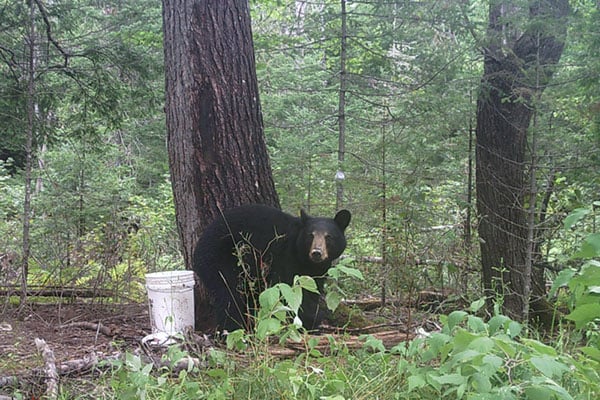
Last Updated on
Hunting black bears in the dense forest is a challenge. We can’t spot and stalk when we can see only 25 feet in front of us. Hounding is still alive and well in some areas, but baiting is the most successful method of harvesting bears in Maine. Approximately 25% of our bear hunters are successful each year in spite of baiting, hounding, snaring, and incidental takes.
Baiting black bears is a lot like baiting deer. We bring them to the food to have time to access the animal and determine its status. Is it a sow with cubs? Is the animal large enough? Is there another reason a smaller animal should be taken? In 2014, after five years of bear hunting in Maine, I harvested my first bear. I studied the game camera photos constantly. I knew which bear I wanted, a big bear that weighed around 250 pounds. I knew which way he came into the site, the trail he left on, how long he stayed at the bait, and how long he was gone before he returned. Instead, I shot a bear with a broken right front leg and dislocated left paw. I was able to watch the bear at the bait for 20 minutes, decide he wouldn’t survive winter because he had a hard time eating, and clicked the safety off.
The most common bait container is a 50 gallon barrel, usually plastic. A hole large enough for a big black bear to reach into is cut out of the center of the barrel. Two small holes are cut in the back to make way for the chain or cable that secures the barrel to a tree. Without that chain or cable, bears will roll the barrel away. Logs are placed into the opening to keep the bears busy longer. This gives you more time to assess the bear and wait for cubs that might be lagging behind.
Five gallon buckets are convenient and easy to carry into the woods, but they’re also easy for a bear to carry away. I drill holes around the barrel, three inches apart, two inches from the top. Bears’ noses are 800 times more sensitive than a human’s nose. The scent of bait on the outside of the bucket and coming through the holes is enough to interest the bear. It takes a lot of cable to keep the bucket on the tree for a while. It’s a good choice for sites that are too remote for a 50 gallon barrel. Lids are difficult to remove and keep pests such as raccoons and opossums out. If you choose a bucket, you’ll need to hone your bucket hunting. Hanging the bucket in the tree slowed them down but didn’t put an end to their thievery. I had to find my bucket three times.
Plastic crates holding bait are hung in trees. Crates are used to bring scent higher into the air more than to let the bears eat. They break easily. Hunters I know place beaver carcasses (for the castor smell) in the crate. They’re used in addition to larger containers.
Hollow logs are gaining popularity. They can be chained to a tree and filled with black bear baits. They don’t have to be carried out when they start to break down. They’re less expensive, possibly free, than buying 50 gallon barrels. You can top them off with a tree cookie to keep rain out if you’re standing them up. A pile of logs works well. You place the bait on the ground and pile the logs on top.
If you’re setting up a site in an open space or in a place that doesn’t have a strong tree, a hole in the ground will work. You can place a container in the hole if you’d like to. Dig the hole, sink the container, refill around the container, and top it off with heavy OSB or plywood. Place heavy rocks on top to keep pests out and to slow down the bears. It’s important to use scents at this bait because most of the smell is sealed in.
What is Bait?
Hunters have their favorite baits. Pastries are most popular, partly because they’re easy to find but mostly because in the fall bears are carb loading. They’re after sweet foods that will build fat for winter hibernation. Pastries, candy, maple syrup, honey, coated popcorn, pails of solid caramel, preserves and pie filling, corn syrup, molasses and raisins are often used. If you’ve been pressing cider, save the solids for the bait site; the sweet smell will drift on the breeze.
In addition to sweet foods, oats mixed with molasses, fryolator oil and bacon grease, dry dog food is also used. Oil and grease smells carry on the wind well so they’re often used outside of the container. Bears follow their noses. We don’t want to feed the raccoons and other pests but we do want them to take the scent of oil and grease away with them.
Spring black bear hunts are a little different. Black bears do go to sweets but they’re looking for protein after a long hibernation. Road kill deer and moose parts might be useful. Expect to draw in coyotes, bobcats and other predators in addition to the bears.
Googling black bear baits will bring up a lot of websites. You can buy baits year round to store, shipped to you, or picked up if available locally. Ask restaurants to save their oil for you. Store your bait in a safe place the bears can’t get into. Sheds are usually not safe. Bears don’t respect doors. Keep it away from your home.
Scent Sprays
Scent sprays help catch the black bears’ attention. Sprays can be applied to trees and tags. I soak a piece of solid cotton in anise, pull down a sapling, tie it on, and let the tree go. Liquid smoke (often called bacon), blueberry, butterscotch, and beaver castor are other options. I spray scent on my boot to leave a scent trail to the bait.
Bait Location
We know why we’re baiting, what to use for containers, and what we’re offering for food, but where do we set up? As always, if you don’t own the land, get landowner permission in advance. I can start baiting four weeks prior to opening day of the hunting season. If you’re setting up a new site, you’ll want to start well ahead of time. It takes time to find a good spot.
There are a few simple rules to keep in mind. It’s late summer and early fall. Bears are putting on their winter coats. They get hot and stop slow down and even stop moving in the heat of the day with one exception – hyperphagia. Bears spend a considerable amount of time in water and low, dark, damp areas. That narrows your options. Find a water source. Our most successful baits are beside bogs and streams.
You should have a strong tree to chain or cable the barrel snugly. You might need to trim brush away from the barrel. Allow a 15 foot circle if possible so you can see the full body while the bear is moving around.
If you’re going to use a tree stand, find a good tree at least 50 feet from the bait. You need room to move without being seen. For a ground blind, a flat spot is important. You need to be able to sit still for hours without balancing on uneven ground. Your seat should sit flat on all four feet. If you’re going to sit on the ground you need to be comfortable.
Place your stand in front of the black bear bait. You’ll bait as early in the day as possible to encourage bears to eat during legal daylight. You don’t want to pass the bait to get to your stand. Slip in through the back quietly. Clean up the trail to remove anything that will trip you while you’re carrying a bucket of bait and a rifle.
You’re probably required to label every site with your name, the landowner’s name, and contact information for both of you. Check the laws. Your label probably has a minimum size so wardens can spot it.
When you’ve filled your tag or the season is over, you will have a specific amount of time to clean up the bait. You might or might not have to remove the container.
Let your bait do what it’s supposed to do – attract bears, bring them into an open area, and give you time to assess the animal. You don’t want to make a mistake like taking a sow away from her cub(s). You need an excellent shot with bears. Their bones are heavy and they are hardy animals. Take the time you need for proper shot placement. If you’re looking for a trophy bear that will put a lot of meat in the freezer, gauge the size of the bear against the barrel or bucket. Size isn’t a good indicator of age. My 150 pound bear had little fat on September 4 because he had a hard time getting to enough food. His belly cleared the top of a five gallon bucket, barely. I’m still waiting on the age report but I’m fairly sure he was an older bear. His teeth were brown and his molars were rotten. Most of the bears at your bait won’t be ones you want to shoot. Enjoy watching the show. You’ll learn a lot watching bears.

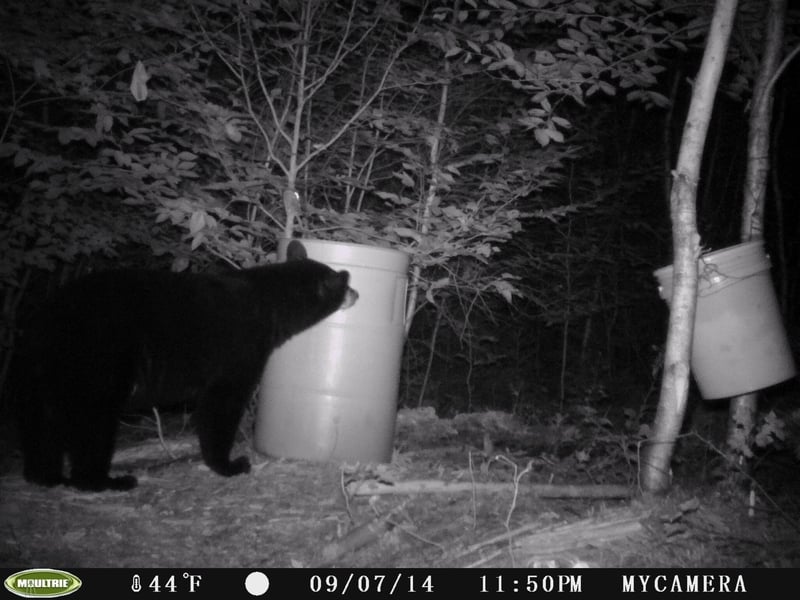
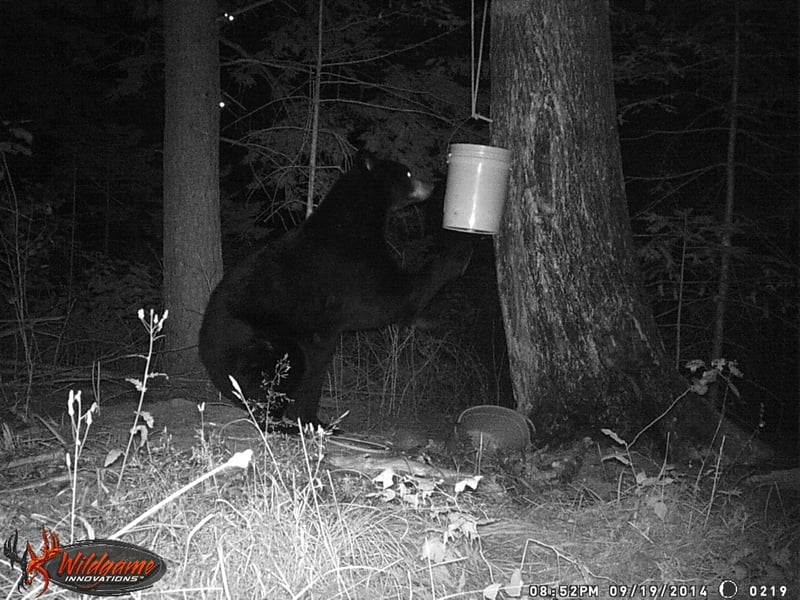
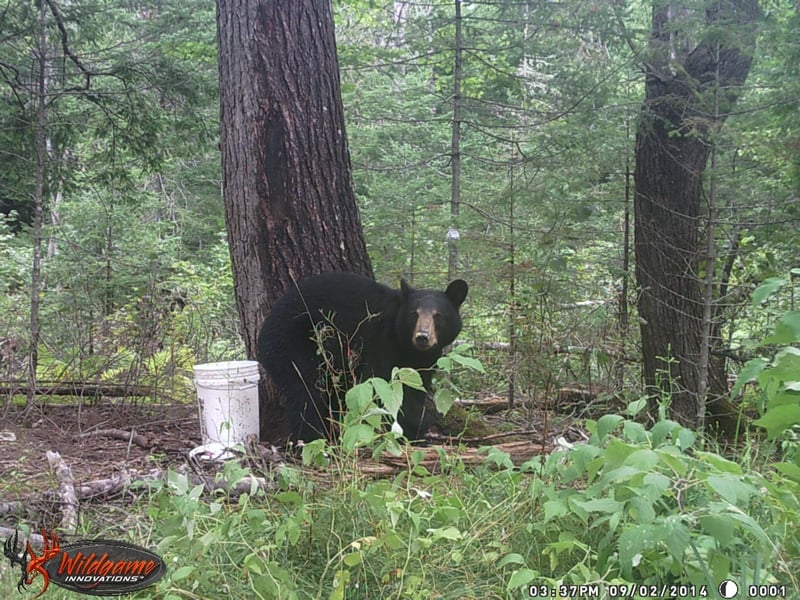

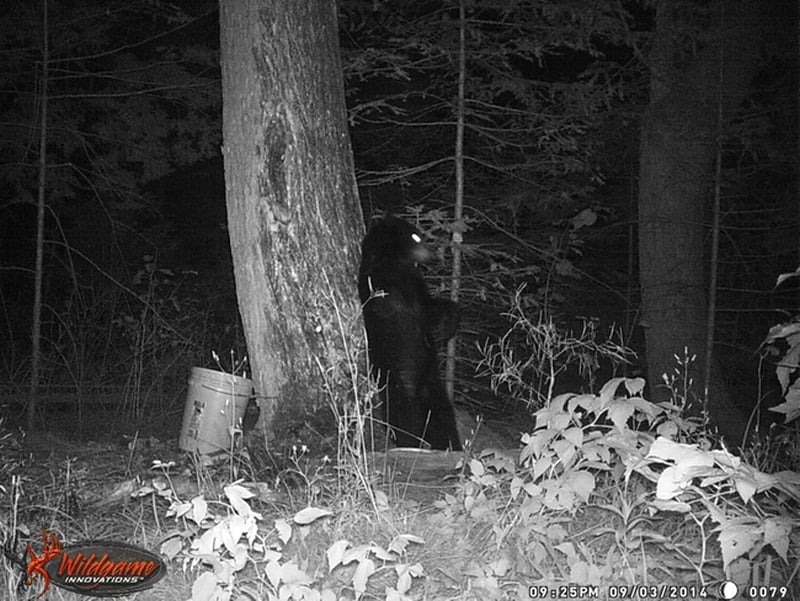




Leave a Reply